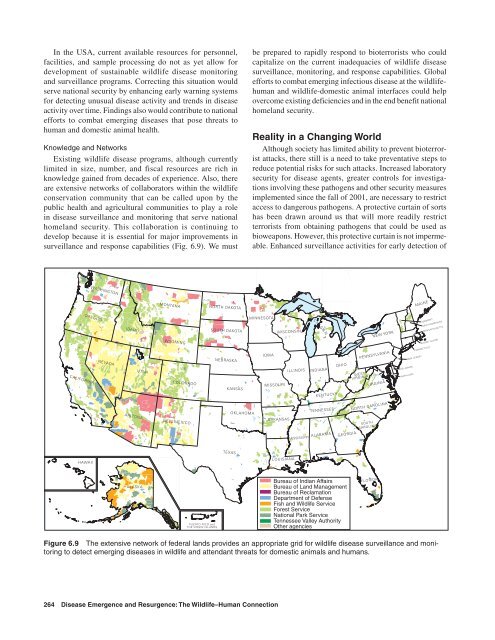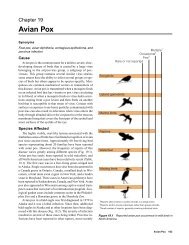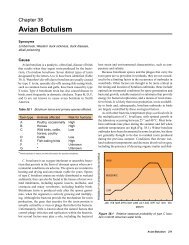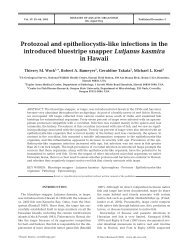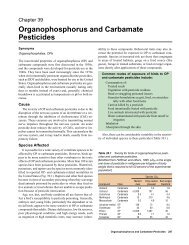In the USA, current available resources for personnel, facilities, <strong>and</strong> sample processing do not <strong>as</strong> yet allow for development of sustainable wildlife dise<strong>as</strong>e monitoring <strong>and</strong> surveillance programs. Correcting this situation would serve national security by enhancing early warning systems for detecting unusual dise<strong>as</strong>e activity <strong>and</strong> trends in dise<strong>as</strong>e activity over time. Findings also would contribute to national efforts to combat emerging dise<strong>as</strong>es that pose threats to human <strong>and</strong> domestic animal health. Knowledge <strong>and</strong> Networks Existing wildlife dise<strong>as</strong>e programs, although currently limited in size, number, <strong>and</strong> fiscal resources are rich in knowledge gained from decades of experience. Also, there are extensive networks of collaborators within the wildlife conservation community that can be called upon by the public health <strong>and</strong> agricultural communities to play a role in dise<strong>as</strong>e surveillance <strong>and</strong> monitoring that serve national homel<strong>and</strong> security. This collaboration is continuing to develop because it is essential for major improvements in surveillance <strong>and</strong> response capabilities (Fig. 6.9). We must ORE GON CAL IFO RNI A HAWAII WASH ING TON NEVA DA IDAH O UTAH ARI ZON A ALASKA MON TANA WYOM ING COL ORA DO NEW MEX ICO PUERTO RICO <strong>and</strong> THE VIRGIN ISLANDS NOR TH DAKOTA SOUT H DAKOTA NEB RAS KA KAN SAS OKL AHO MA TEX AS 264 Dise<strong>as</strong>e Emergence <strong>and</strong> Resurgence: The Wildlife–Human Connection be prepared to rapidly respond to bioterrorists who could capitalize on the current inadequacies of wildlife dise<strong>as</strong>e surveillance, monitoring, <strong>and</strong> response capabilities. Global efforts to combat emerging infectious dise<strong>as</strong>e at the wildlifehuman <strong>and</strong> wildlife-domestic animal interfaces could help overcome existing deficiencies <strong>and</strong> in the end benefit national homel<strong>and</strong> security. Reality in a Changing World Although society h<strong>as</strong> limited ability to prevent bioterrorist attacks, there still is a need to take preventative steps to reduce potential risks for such attacks. Incre<strong>as</strong>ed laboratory security for dise<strong>as</strong>e agents, greater controls for investigations involving these pathogens <strong>and</strong> other security me<strong>as</strong>ures implemented since the fall of 2001, are necessary to restrict access to dangerous pathogens. A protective curtain of sorts h<strong>as</strong> been drawn around us that will more readily restrict terrorists from obtaining pathogens that could be used <strong>as</strong> bioweapons. However, this protective curtain is not impermeable. Enhanced surveillance activities for early detection of MINNESOTA IOWA MIS SOU RI WIS CON SIN ARK ANSAS LOU ISI ANA M ILL INO IS A MISSISSIPP I I C H I A G N IND IAN KEN TUC KY TEN NES SEE ALA BAM A OHI O GEO RGI A Bureau of Indian Affairs Bureau of L<strong>and</strong> Management Bureau of Reclamation Department of Defense Fish <strong>and</strong> Wildlife Service Forest Service National Park Service Tennessee Valley Authority Other agencies PEN NSY LVAN IA WES T VIR GIN IA DC VIR GIN IA NOR TH CAR OLI NA SOUT H CAR OLI NA FLO RIDA NEW YORK Figure 6.9 The extensive network of federal l<strong>and</strong>s provides an appropriate grid for wildlife dise<strong>as</strong>e surveillance <strong>and</strong> monitoring to detect emerging dise<strong>as</strong>es in wildlife <strong>and</strong> attendant threats for domestic animals <strong>and</strong> humans. NEW JER SEY DEL AWAR E MARY LAN D MAI NE VER MON T NEW HAM PSH IRE MAS SACH USET TS RHO DE ISL AND CON NEC TIC UT
flaws in this protective curtain will be bolstered by enhanced strategic planning, infr<strong>as</strong>tructure development, <strong>and</strong> rapid response capabilities that minimize impacts <strong>and</strong> quickly repair damage that may occur. Furthermore, the current curtain <strong>as</strong>sumes frontal attacks by known enemies using familiar tactics for exposing humans <strong>and</strong> domestic animals to dangerous pathogens. The vulnerability of the curtain to unconventional attacks also needs to be addressed. Wildlife have a great capability to breach the protective curtain <strong>and</strong> e<strong>as</strong>ily p<strong>as</strong>s through its fabric. Examples include infectious dise<strong>as</strong>es transported by wildlife that caused major economic <strong>and</strong>/or human health impacts, such <strong>as</strong> Nipah virus in Malaysia, 131,132 SARS in China, 133–137 monkeypox in the USA, 138 <strong>and</strong> current concerns <strong>as</strong>sociated with the role of migratory birds in global movement of highly pathogenic H5N1 influenza virus. Wildlife <strong>and</strong> the dise<strong>as</strong>es that they can transport represent flaws in the fabric of this protective curtain <strong>and</strong> can be exploited by terrorists in attacks against society. The protective curtain can be greatly strengthened by fully incorporating the wildlife factor into its fabric. This refurbishment <strong>and</strong> enhancement can serve society well in many ways, including contributions to the larger issue of infectious dise<strong>as</strong>e emergence <strong>and</strong> resurgence worldwide. Milton Friend Literature Cited 1. Lederberg, J., 1999, Epilogue, in Lederberg, J., ed., Biological weapons: limiting the threat: Cambridge, M<strong>as</strong>s., MIT Press, p. 321–329. 2. Litsios, S., 2001, Plague legends: from the mi<strong>as</strong>m<strong>as</strong> of Hippocrates to the microbes of P<strong>as</strong>teur: Chesterfield, Mo., Science <strong>and</strong> Humanities Press, 249 p. 3. Théodoridès, J., 1986, Histoire de la rage: cave canem: Paris, M<strong>as</strong>son, 289 p. 4. Bodson, L., 1994, Ancient views on pests <strong>and</strong> par<strong>as</strong>ites of livestock: Argos, v. 10, p. 303–306. 5. Blancou, J., 2003, History of the surveillance <strong>and</strong> control of transmissible animal dise<strong>as</strong>es: Paris, France, Office International des Epizooties, 362 p. 6. Fenner, F., Henderson, D.A., Arita, I., Ježek, Z., <strong>and</strong> Ladnyi, I.D., 1988, Smallpox <strong>and</strong> its eradication: Geneva, Switzerl<strong>and</strong>, World Health Organization, 1460 p. (http:// www.who.int/emc/dise<strong>as</strong>es/smallpox/Smallpoxeradication. html) 7. Fleming, G., 1871, <strong>Animal</strong> plagues: their history, nature, <strong>and</strong> prevention: London, UK, Chapman <strong>and</strong> Hall, 548 p. 8. Kohn, G.C., ed., 1995, Encyclopedia of plague <strong>and</strong> pestilence: New York, N.Y., Facts on File, Inc., 408 p. 9. McNeill, W.H., 1976, Plagues <strong>and</strong> peoples: Garden City, N.Y., Anchor Press, 369 p. 10. Morse, S.S., 1993, Emerging viruses: Oxford, UK, Oxford University Press, 317 p. 11. Verano, J.W., <strong>and</strong> Ubelaker, D.H., eds., 1992, Dise<strong>as</strong>e <strong>and</strong> demography in the Americ<strong>as</strong>: W<strong>as</strong>hington, D.C., Smithsonian Institution Press, 294 p. 12. Lederberg, J., 2000, Infectious history: Science, v. 288, p. 287–293. 13. Ban, J., 2000, Agricultural biological warfare: an overview: Alex<strong>and</strong>ria, Va., Chemical <strong>and</strong> Biological Arms Control Institute, The Arena, no. 9, p. 1–8. (http://www.mipt.org/ pdf/agrobiowarfareoverview.pdf) 14. Geissler, E., <strong>and</strong> van Courtl<strong>and</strong> Moon, J.E., eds., 1999, Biological <strong>and</strong> toxin weapons: research, development <strong>and</strong> use from the Middle Ages to 1945: Oxford, UK, Stockholm International Peace Research Institute <strong>and</strong> Oxford University Press, 279 p. 15. Osterholm, M.T., 2001, <strong>Bioterrorism</strong>: a real modern threat, in Scheld, W.M., Craig, W.A., <strong>and</strong> Hughes, J.M., eds., Emerging Infections 5: W<strong>as</strong>hington, D.C., ASM Press, p. 213–222. 16. Wheelis, M., 2002, Biological warfare at the 1346 Siege of Caffa: Emerging Infectious <strong>Dise<strong>as</strong>es</strong>, v. 8, p. 971–975. 17. Wheelis, M., 1999, Biological warfare before 1914, in Geissler, E., <strong>and</strong> van Courtl<strong>and</strong> Moon, J.E., eds., Biological <strong>and</strong> toxin weapons: research, development <strong>and</strong> use from the Middle Ages to 1945: Oxford, UK, Oxford University Press, p. 8–34. 18. Norris, J., 1977, E<strong>as</strong>t or west? The geographic origin of the Black Death: Bulletin of the History of Medicine, v. 51, p. 1–24. 19. Inglesby, T.V., Dennis, D.T., Henderson, D.A., Bartlett, J.G., Ascher, M.S., Eitzen, E., Fine, A.D., Friedl<strong>and</strong>er, A.M., Hauer, J., Koerner, J.F., Layton, M., McDade, J., Osterholm, M.T., O’Toole, T., Parker, G., Perl, T.M., Russell, P.K., Schoch-Spana, M., <strong>and</strong> Tonat, K., for the Working Group on Civilian Biodefense, 2000, Plague <strong>as</strong> a biological weapon: medical <strong>and</strong> public health management: Journal of the American Medical Association, v. 283, p. 2281–2290. 20. Perry, R.D., <strong>and</strong> Fetherston, J.D., 1997, Yersinia pestis: etiologic agent of plague: Clinical Microbiology Reviews, v. 10, p. 35–66. 21. Slack, P., 1989, The black death p<strong>as</strong>t <strong>and</strong> present: Transactions of the Royal Society of Tropical Medicine <strong>and</strong> Hygiene, v. 83, p. 461–463. 22. Christopher, G.W., Cieslak, T.J., Pavlin, J.A., <strong>and</strong> Eitzen, E.M., Jr., 1997, Biological warfare: a historical perspective: Journal of the American Medical Association, v. 278, p. 412–417. 23. Harris, S.H., 2002, Factories of death: Japanese biological warfare, 1932–1945, <strong>and</strong> the American cover-up: New York, N.Y., Routledge, 385 p. 24. Inglesby, T.V., 2001, Bioterrorist threats: what the infectious dise<strong>as</strong>e community should know about anthrax <strong>and</strong> plague, in Scheld, W.M., <strong>and</strong> Hughes, J.M., eds., Emerging Infections 5: W<strong>as</strong>hington, D.C., ASM Press, p. 223–234. 25. World Health Organization, 1970, Health <strong>as</strong>pects of chemical <strong>and</strong> biological weapons: Geneva, Switzerl<strong>and</strong>, p. 98–109. 26. Alibek, K., <strong>and</strong> H<strong>and</strong>elman, S., 1999, Biohazard: the chilling true story of the largest covert biological weapons program in the world, told from the inside by the man who ran it: New York, N.Y., R<strong>and</strong>om House, 319 p. 27. Frist, W.H., 2002, When every moment counts: what you need to know about bioterrorism from the Senate’s only doctor: Lanham, Md., Rowman <strong>and</strong> Littlefield Publishers, <strong>Biowarfare</strong>, <strong>Bioterrorism</strong>, <strong>and</strong> <strong>Animal</strong> <strong>Dise<strong>as</strong>es</strong> <strong>as</strong> <strong>Bioweapons</strong> 265
- Page 1 and 2: Chapter 6 Biowarfare, Bioterrorism,
- Page 3 and 4: Chapter 6 Biowarfare, Bioterrorism,
- Page 5 and 6: of war) and as many as several hund
- Page 7 and 8: Table 6.1 Examples of infectious ag
- Page 9 and 10: (e.g., animals and humans) may be a
- Page 11 and 12: sophisticated knowledge or expensiv
- Page 13 and 14: attack (Sarin) of the Tokyo subway
- Page 15 and 16: Animal Disease and Bioterrorism “
- Page 17 and 18: Table 6.4 Category B (second highes
- Page 19 and 20: Anthrax is an example of a “doubl
- Page 21 and 22: Table 6.6. Disease agents posing th
- Page 23 and 24: Table 6.6. Disease agents posing th
- Page 25 and 26: The Wildlife Factor “…and he th
- Page 27 and 28: Table 6.9b. Animal pathogens being
- Page 29 and 30: information flow, and reporting are
- Page 31 and 32: Table A. Examples of infectious dis
- Page 33: Figure 6.6 The close proximity betw
- Page 37 and 38: health control: Oxford, UK, Oxford
- Page 39 and 40: Campagnoli, R., Icenogle, J.P., Pe
- Page 41 and 42: of wild mammals (3rd ed.): Ames, Io


